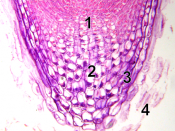Root in botany, is the descending axis of a plant, as contrasted with the stem, the ascending axis. In most plants the root is underground, but in epiphytes the roots grow in the air and in hydrophytes (e.g., cattails and water lilies) they grow in water or marshes. Roots function to absorb water and dissolved minerals from the soil, to anchor the plant, and often to store food. There are two main types of root system: the tap-root system, in which there is a main primary root larger than the other branching roots; and the diffuse (or fibrous) root system, in which there are many slender roots with numerous smaller root branches. Tap roots are characteristic of most trees and of many other plants, including the carrot, parsnip, radish, beet, and dandelion. The grasses (e.g., corn, rye, and alfalfa) have diffuse roots; in the sweet potato some of the larger fibrous roots swell to store food--although these should not be confused with the tuber of the Irish potato, which is a modified underground stem .
Root systems often far exceed in mass the aboveground portions of the plant: alfalfa roots sometimes reach 40 ft (12 m) in length, and the combined length of all the roots of a mature rye plant has been measured at 380 mi (612 km).
These ramified root systems are important agents in preventing soil erosion. Roots grow primarily in length; only the older roots may develop a cambium layer that increases their diameter. Protecting the constantly growing tip of the root is a cap of cells that break off as the root probes through the soil; they are replaced by new cells from a layer of meristematic tissue just behind them. In the center of the root the cells formed earlier by...


